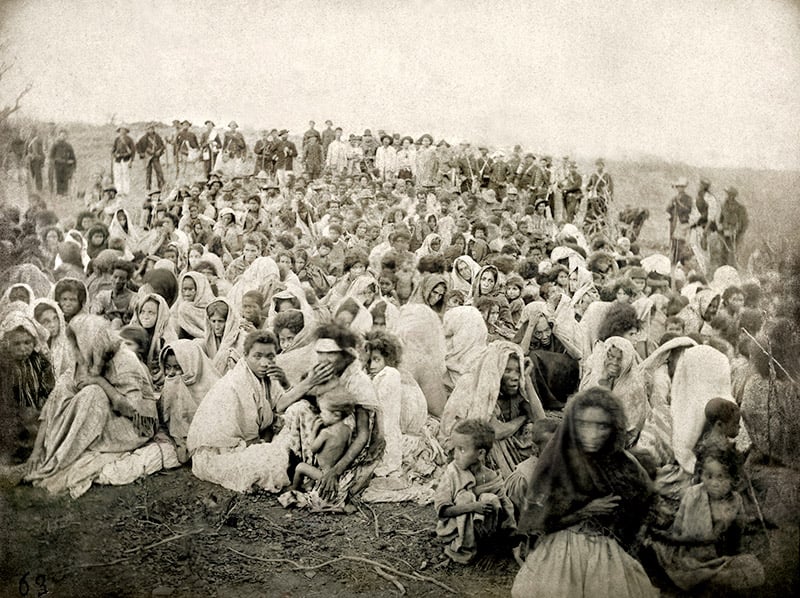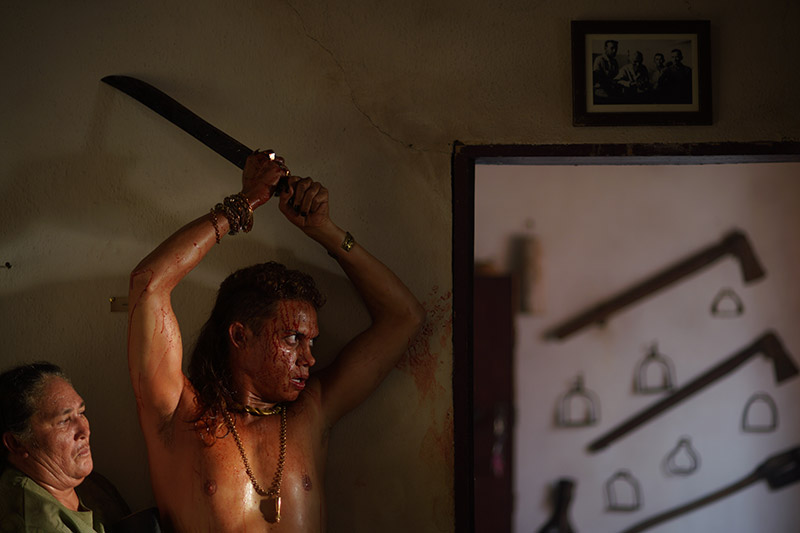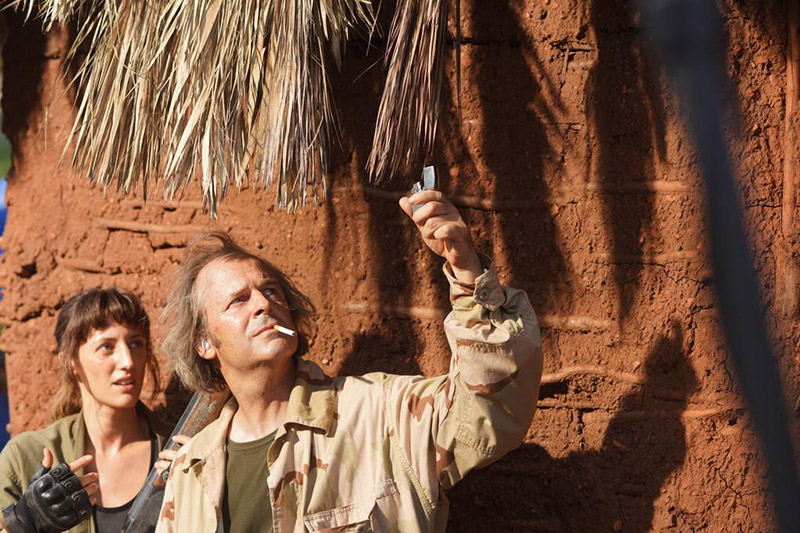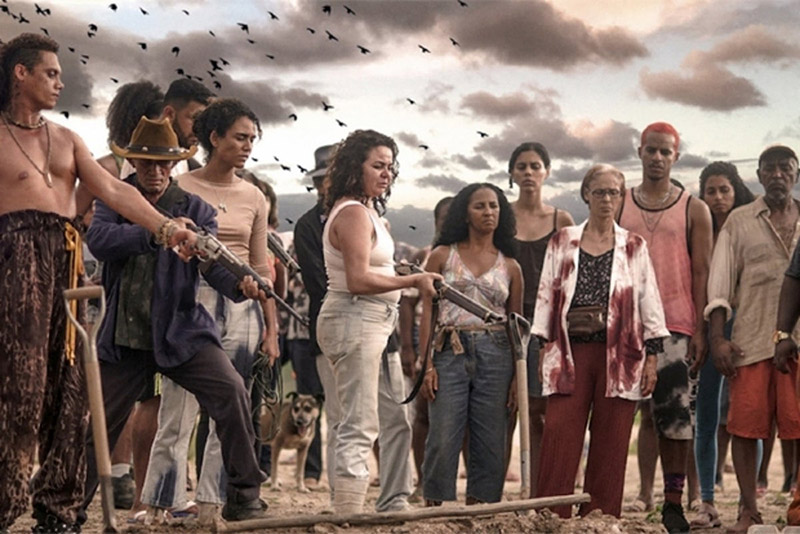Rebellion in the Backlands
“There is no therapy for the rage brought about by the clash of races suddenly fused into a single organism.” —Euclides da Cunha, Backlands

“400 jagunços prisioneiros,” 1897, a photograph by Flávio de Barros. Courtesy of the Museum of the Republic and the Moreira Salles Institute.
At last year’s esteemed International Literary Festival in Paraty, Brazil, I happened upon a small photography exhibit mounted inside of a semitruck. Titled Conflicts and organized by the Moreira Salles Institute, the show presented a selection of images that tracked Brazil’s violent political conflicts and resurrections since the country became a republic. One particularly gruesome photograph from 1894 showed an opposition rebel being decapitated during a civil war. The executing soldier’s cold gaze meets the viewer’s eye as the blood gushes from his victim’s neck.
A photograph of severed heads, arranged in a line, also punctuates a quiet, eerie scene in Kleber Mendonça Filho and Juliano Dornelles’s excellent new film, Bacurau. With its epic CinemaScope imagery, wild plot, and acerbic sociopolitical critique, Bacurau is likely the best revenge thriller we’ll see this year—on par with last year’s Parasite, by Bong Joon-ho. In Bacurau, a group of white, foreign thrill seekers have paid for the right to kill everyone in Bacurau, a small town in Brazil’s northeast. (The gunmen prepare by metaphorically wiping Bacurau off the map—through technology that blocks GPS and cell phone signals, the town disappears from Google Earth.) But once the townsfolk understand what’s happening, they unite and rise up against the invaders. As one of the remaining killers wanders through Bacurau’s tiny museum, a resident silently appears and chops him up with a machete. The would-be conqueror’s blood spurts across the walls—right next to the above-mentioned photograph of decapitation. Then the film’s bloodbath culminates with the local bandit, Lunga, who’s been summoned to defend the town, carrying severed heads onto the main square—as Bacurauans record the scene on their cell phones.
That gruesome yet triumphant moment is further complicated by COVID-19: you cannot experience it with people from your own city in a movie theater. Bacurau has joined the innumerable films, books, art exhibitions, and concerts that have been disrupted by the pandemic. Though there are innumerable urgent crises at the moment—such as President Jair Bolsonaro undermining mayors who have attempted to enforce his own government’s guidelines about staying indoors, and threatening to fire the Health Minister who declared the isolation measures—the deferment or neglect of so many new artworks during this time is a loss worth observing. How artists and art organizations, whose finances have been tenuous for years, can withstand the economic ravages of the coronavirus is unclear.
Bacurau (available to stream on the distributor’s site), with an apocalyptic setting perfectly suited for these times, offers a crystal clear critique of the era of Bolsonaro, but also of Brazil’s fraught past. The film’s epic scale, unrelenting narrative, and cutting depiction of violence all bring to mind Euclides da Cunha’s Backlands: The Canudos Campaign (1902), which offers an eyewitness account of the worst civilian massacre in Brazilian history. Spanning nearly seven hundred pages and mixing sociology, geology, military history, and philosophy, the book provides a useful lens on the state’s continuous use of violence to maintain control of its population, from colonization to its military dictatorship to Bolsonaro.
Understanding Backland’s renewed relevance under Bolsonaro opens up the experience of Bacurau. Mendonça and Dornelles’s film is, just like Backlands, an attempt to grapple with unspeakable, horrifying evil—but an evil that must be understood in social and historical rather than biblical terms.

All stills from Bacurau. Courtesy Kino-Lober
Like the foreign invaders of the film, the Brazilian army that invaded Canudos viewed itself as a civilizing force far superior to those they sought to destroy. Antônio Conselheiro, an itinerant preacher, founded Canudos on secluded, inhospitable land in 1893. Conselheiro opposed levying excessive taxes and pronounced his loyalty to the Portuguese crown; soon, newspapers around the country described Canudos as an armed promonarchist outpost that also had offices in New York, Buenos Aires, and Paris. Authorities found this (and the bandits who lived among the villagers) to be a threat to the stability of the republic. Brazil had only secured its independence from Portugal in 1889 with a military coup, and was still jittery from various mutinies and rebellions across its vast territory. A hundred soldiers marched on the town in November 1896, but failed to seize control.
Da Cunha, then a correspondent for A Província de São Paulo, arrived in the region late into the campaign. He wrote about the backlanders’ defense, often reducing individuals to stereotypes: Big John, the “strongly built but agile black man”; “a burly mameluco [Mamluk, an Arabic designation for slave] with the body of a gladiator”; “a mestizo of unmatched bravery and ferocity.” Despite the failure of a second campaign in January 1897 the government was certain that victory was near. Da Cunha reported how troops were feted with banquets in the nearby town that served as a base, and that “energetic corrective measures were needed to drag [these backward heathens] out of the barbaric behavior that was a stain on our country.”
When the soldiers return and Canudos resists, the author denounces the army’s poor discipline and low morale. His scorn intensifies in descriptions of the skirmishes he witnessed firsthand. The officers fail to reign in the panicked soldiers, some of whom, “mostly mestizos, the same race as the backlanders,” are “filled with irrational terror.” Others decapitate rebels and civilians, “often the eager murderers,” with “the tacit approval of the leadership.… In spite of three centuries of underdevelopment, the sertanejos did not rival our troops in acts of barbarism.”
The rebels, on the other hand, are Davids fighting Goliath. Of one such fighter, da Cunha writes: “a Hercules-Quasimodo, he expressed in his posture the typical ugliness of the weak.” The quintessential da Cunhian paradox mixes beauty and strength with a vision of a monstrous hunchback. The effect, as the Mexican essayist Ilan Stavans notes in the introduction to the Penguin edition, is dehumanizing. Yet, da Cunha admires the rebels’ refusal to surrender, and describes scenes of them mourning their dead as if he had joined them, acknowledging that pain and horror of death are shared by both sides. “These were not fighters, but the faithful, carrying their dead in crude litters made of wooden poles tied with liana stalks,” he writes. “They were honoring the martyrs of the faith. They had spent the day searching for the bodies, a sad task that occupied the entire settlement.”
 Bacurau also has its David: the bandit, Lunga, who’s been hiding from the authorities, but returns to town when its residents plead with him to defend it. Lunga and his small band of rebels bust out the dusty guns from the museum – relics to defeat high-tech invaders (who, ironically, also use antique weapons, as fetishes). Lunga is lithe and handsome, disciplined and admired, but also ruthless and uncompromising—a mix that captures the ethos and complexity of modern-day banditry. (Nota bene, the quarantine against COVID-19 in Rio de Janeiro’s favelas is being enforced by drug traffickers.)
Bacurau also has its David: the bandit, Lunga, who’s been hiding from the authorities, but returns to town when its residents plead with him to defend it. Lunga and his small band of rebels bust out the dusty guns from the museum – relics to defeat high-tech invaders (who, ironically, also use antique weapons, as fetishes). Lunga is lithe and handsome, disciplined and admired, but also ruthless and uncompromising—a mix that captures the ethos and complexity of modern-day banditry. (Nota bene, the quarantine against COVID-19 in Rio de Janeiro’s favelas is being enforced by drug traffickers.)
In one of Bacurau’s most provocative scenes, the foreign attackers converse with the white Brazilian couple who are being paid to help them realize their mass-murdering plan. The couple feels that they have little in common with Bacurau and the rest of Brazil, because they hail from the country’s wealthy South. “How could you be like us?” a foreigner jeers. Pointing at the pair, he asks his companions, “They’re not white, right?” “They kind of look white. But they’re not,” another foreigner says, adding that the woman’s lips and nose “give her away.” The blunt scene reveals not just the prejudice against Latinos and other non-Westerners, but also white Southern Brazilians’ sense of racial and cultural superiority over their Northeastern countrymen.
In a similar vein, despite valorizing Canudos residents in certain moments, da Cunha concluded that the Northeast’s inferior geology bred inferior men, and that miscegenation put the Brazilian nation at risk. He expresses his conviction that “civilization will advance across the backlands,” and that this will lead to “the inevitable crushing of the weak races by the strong.” He repeatedly frames the northeasterners, but particularly those who were black, mestizo, and indigenous, as atavistic and bound for extinction.
In the press, da Cunha’s opinions on race were explicit—he regularly wrote in favor of genetic determinism. Borrowing terminology from Darwinist science, determinism spread thanks to European writers read in Brazil and the United States. Among its adherents was the Brazilian anthropologist Raimundo Nina Rodrigues, who examined Conselheiro’s cranium. The preacher’s body was exhumed at the end of the war and his head was cut off and sent to a lab in Rio. Rodrigues did not find abnormalities, yet his essay, “The Madness Epidemic of Canudos” (1897), characterized the preacher as a megalomaniacal lunatic. An author of early anthropological studies on Brazil’s Afro-descendant cultures—referenced by da Cunha in Backlands—Rodrigues nevertheless considered mestiçagem, or miscegenation, to be “a biological problem,” “a decadence” (“Miscegenation, Degeneracy and Crime,” 1894). Not surprisingly, he attributed Conselheiro’s madness partly to his being a backlands mestizo. Taking a cue from Rodrigues, da Cunha deprecates “the mestizo religion with its tendencies to idol worship,” contrasting it with Christian beliefs.
The contradictions around race, class, and region that recur throughout Backlands are inherent to Brazil. In the early years of Brazilian independence, artists embraced indianismo, an idealized conception of the indigenous, to represent the nation, and would often depict indigenous women in classical European styles. This trend extended to literature as well: Iracema (1865), a classic by José de Alancar, is the Brazilian equivalent of the Pocahontas legend. It wouldn’t be until a century later, during the military regime’s push into the Amazon with the creation of the Trans-Amazonian Highway, that Jorge Bodanzky and Oswaldo Senna made the docudrama Iracema—Uma Transa Amazônica (1974) to expose the reality behind the myth. Edna de Cássia, a Brazilian actress of indigenous descent, portrays Iracema as an underage girl who makes her living as a sex worker. She meets a white truck driver (Paulo César Peréio) in Belem and travels with him across the newly built highway, bearing witness to an impoverished region whose economy almost exclusively relies on the exploitation of people and natural resources.
In one painful moment, Cássia denies her race, telling her blond, blue-eyed companion that she considers herself white. Her lie—or self-delusion—is no less tragic than the fact that da Cunha was mestizo. Their respective rejections, in very different eras and contexts, speak volumes about the contradictory relationships many Brazilians have with race. Despite artists respectfully engaging with and centering nonwhite Brazilians in their work throughout the twentieth century—as in Oswaldo de Andrade’s landmark text, The Anthropophagic Manifesto (1928), which posited that true Brazilian culture is rooted in indigenous and Afro-Brazilian traditions—the state actively discriminated against a great number of its citizens. The state and federal policy of branqueamento (whitening), which was also based in eugenics, subsidized the immigration of white European settlers to Brazil in the early days of the republic in the hopes that they would mix with the inferior races, leading to the eventual wiping out of the latter. The Brazilian language still uses “black” as pejorative in various phrases: “a coisa tá preta,” literally “the thing is black,” which means “it’s not going well;” or “serviço de preto,” literally “black service,” for a poorly done job.
Black Brazilians have also been habitually underrepresented in government. In the months before Bolsonaro’s election, the country was shaken by the murder of a notable outlier: the black politician Marielle Franco. Franco was an outspoken LGBTQ and Afro-Brazilian activist who opposed big-money interests and defended those of poor communities in Rio de Janeiro. The sluggish investigation into her murder rekindled a sense that there’s no justice for black Brazilians, or that, as the journalist Eliane Brum writes in her recent book, The Collector of Leftover Souls, there is not one, but many Brazils.

Yet, as Bacurau’s bloody, triumphant conclusion shows, violence hasn’t been only exercised by the powerful in the name of social change. During the push for abolition, slaves assassinated slave owners, coordinated attacks on plantations, rebelled, and used subversive tactics such as the breaking of farm tools. Their leaders also relied on quilombos, settlements created by escaped slaves. While Brazilian cities are highly segregated (a fact visible even in the architecture), the quilombos currently awaiting recognition depend on Bolsonaro, who has continuously supported the interests of agribusiness (with large land holdings historically concentrated in the hands of rich, white landowners) against quilombo and indigenous claims. Yet what struck me in Paraty was the black communities’ determination to state and defend their rights. On a panel dedicated to contemporary resistance movements and black activism, the regional activist Marcela Cananéa, of the Forum of Traditional Communities representing Paraty, Angra, and Ubatuba, said, “Our resistance is a daily reality to maintain our territories, but we must also fight for our basic rights. It is not enough to be recognized as a quilombo, with a proper land demarcation, if you don’t have access to education, health, or electricity.” Cananéa expressed her hope that the recent recognition as a UNESCO patrimonial site of Paraty, and of the region around Ilha Grande Bay—which includes indigenous land and a number of quilombos—will help raise awareness of these communities’ cultural importance. Cananéa added, “Euclides da Cunha spoke of sertanejos as a strong people. Here, the mestizos are equally strong. Various cultures interconnect. Here too, our coast is still the backlands.”


